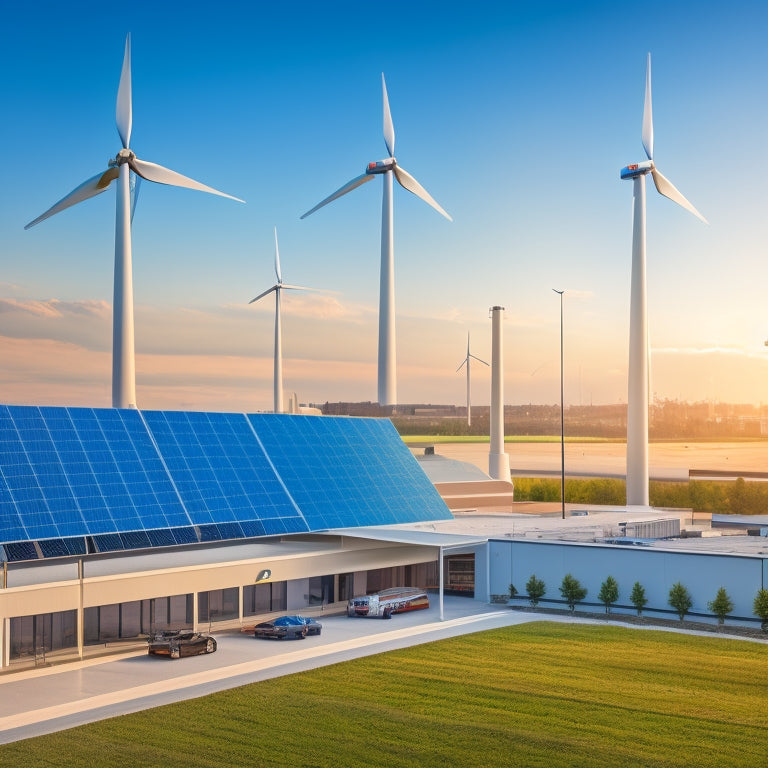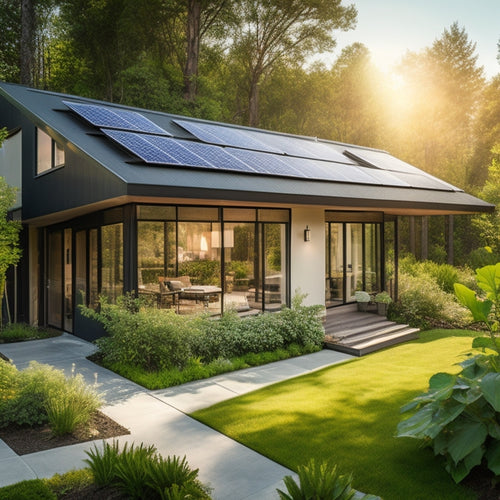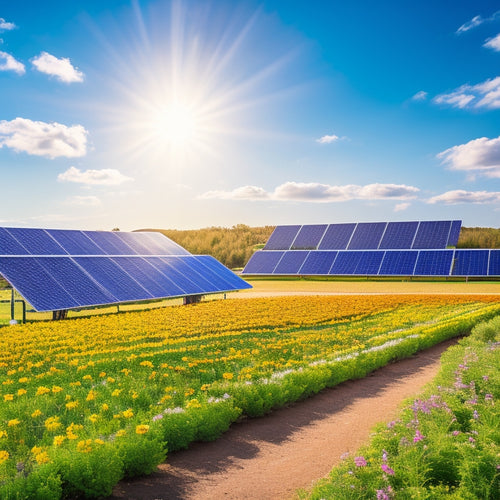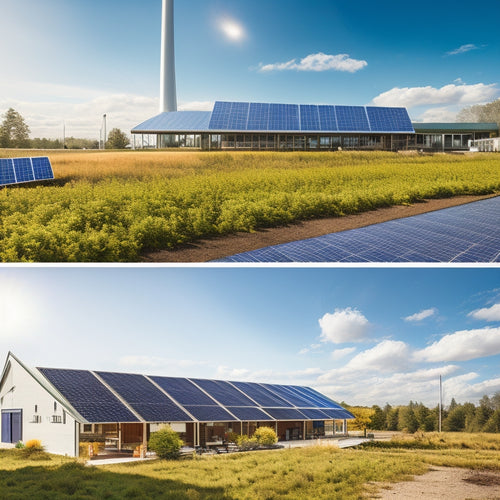
Cut Energy Bills With Industrial-Scale Power Solutions
Share
By investing in industrial-scale power solutions, you can greatly reduce your energy bills, with companies that switch to solar power saving up to 75% on their electricity costs. This makes it an essential step towards achieving long-term energy cost savings. Industrial-scale solar installations can transform industries with cleaner energy, maintain grid resilience, and guarantee a reliable power supply. To maximize energy efficiency gains, you need to optimize system design, conduct thorough energy audits, and implement energy-efficient technologies. By doing so, you'll be on the path to minimizing energy waste and maximizing energy output - and there's more to explore on this journey.
Key Takeaways
• Industrial-scale solar installations reduce reliance on grid electricity, mitigating rising energy costs and enhancing supply chain resilience.
• Optimizing system design and energy audit strategies help identify energy-intensive areas, reducing energy waste and maximizing output.
• Implementing energy-efficient technologies and optimizing operational practices can significantly cut energy consumption costs.
• Large-scale energy harvesting with cleaner energy sources transforms industries, maintains grid resilience, and ensures a reliable power supply.
• Conducting energy monitoring and tracking performance metrics in real-time help pinpoint opportunities for cost reduction and maximize energy output.
Commercial Solar Panel Benefits
By incorporating commercial solar panels into your business's energy infrastructure, you can significantly decrease your dependence on the grid and enjoy substantial savings on your electricity bills. Not only will you lower your operating expenses, but you'll also reduce your carbon footprint, generating valuable carbon credits in the process.
Additionally, many governments offer incentives for businesses that invest in renewable energy, providing a further financial boost. These government incentives can help offset the initial investment costs, making the shift to solar power even more appealing.
Maximizing Energy Efficiency Gains
When you're looking to maximize energy efficiency gains, you'll want to start by optimizing your system design to make sure it's running at peak performance. This involves identifying areas where energy is being wasted and implementing strategies to reduce consumption.
Optimize System Design
You can achieve significant energy efficiency gains by optimizing your system design, which involves identifying and addressing inefficiencies in the power distribution architecture. By doing so, you'll be able to create a more streamlined system that reduces energy waste and maximizes output.
Effective system integration is essential, as it allows you to seamlessly connect different components and optimize energy flow. Furthermore, design flexibility is vital, as it enables you to adapt to changing energy demands and adjust your system accordingly.
Energy Audit Strategies
Implementing a thorough energy audit strategy is essential to identifying areas of inefficiency and tapping into significant energy savings in your industrial-scale power system. You'll want to start by conducting an exhaustive energy mapping exercise to pinpoint energy-intensive areas and prioritize opportunities for improvement. This will help you identify potential savings and develop a roadmap for optimization.
Additionally, be sure to explore available utility incentives that can help offset the costs of energy-efficient upgrades. By taking a holistic approach to energy auditing, you'll be well on your way to maximizing energy efficiency gains and cutting energy bills. With a solid strategy in place, you'll be in control of your energy usage and poised to reap the benefits of a more efficient power system.
Industrial Scale Solar Installations
As you consider industrial-scale solar installations, you're likely thinking about how to harness the power of the sun on a massive scale. To achieve this, you'll need to focus on large-scale energy harvesting, strategic panel installation, and maximizing energy output.
Large-Scale Energy Harvesting
Harnessing renewable energy on a massive scale, industrial-scale solar installations are transforming the way industries generate power, offering a cleaner and more sustainable alternative to traditional fossil fuels.
As you consider large-scale energy harvesting, you're likely thinking about how to maximize your energy output while maintaining grid resilience. One key strategy is to incorporate energy storage solutions that can absorb excess energy generated during the day and release it as needed. This not only helps stabilize the grid but also guarantees a reliable power supply.
Panel Installation Strategies
When designing an industrial-scale solar installation, you'll need to optimize panel installation strategies to minimize land usage, reduce shading, and maximize energy yield per acre.
A well-planned installation ensures structural integrity, guaranteeing the safety and longevity of your system. Consider the site's topography and surrounding obstacles to determine the best panel angle and orientation.
Make sure rooftop access is important and convenient for maintenance and repairs. This is vital for reducing downtime and ensuring prompt issue resolution.
By adopting a thoughtful installation strategy, you'll be able to maximize your energy output while minimizing costs and environmental impact.
With careful planning, you can create a highly efficient industrial-scale solar installation that meets your energy needs while maintaining a strong bottom line.
Maximizing Energy Output
To maximize energy output from your industrial-scale solar installation, you'll need to carefully consider several key factors that impact your system's overall performance. Energy monitoring plays an essential role in identifying areas for improvement, allowing you to pinpoint inefficiencies and take corrective action.
By leveraging advanced monitoring systems, you can track performance metrics in real-time, detecting issues before they escalate into major problems. Performance optimization is also vital, as it enables you to fine-tune your system to achieve peak energy output.
Reducing Energy Consumption Costs
By implementing energy-efficient technologies and optimizing operational practices, you can greatly reduce energy consumption costs and maximize your return on investment. To achieve this, you need to conduct a thorough energy monitoring process to identify areas of inefficiency. This involves tracking your energy usage patterns, identifying peak demand periods, and analyzing your energy consumption data.
A detailed cost analysis will help you pinpoint opportunities for cost reduction. By pinpointing energy-intensive processes and optimizing your operations, you can minimize waste and reduce your energy expenditure. With data-driven insights, you can make informed decisions to optimize your energy usage, reduce your energy bills, and improve your bottom line.
Solar Power for Warehouses Too
Your warehouse operations can greatly benefit from harnessing the power of solar energy, reducing your reliance on grid electricity and mitigating the impact of rising energy costs. By integrating solar panels into your warehouse layout, you can optimize energy security and reduce your carbon footprint.
This, in turn, can improve your supply chain resilience and enhance your reputation as a responsible business. Effective warehouse management and inventory control can be maintained while embracing sustainable energy.
Additionally, land utilization can be maximized by leveraging rooftop or ground-mounted solar installations. By adopting solar power, you can take control of your energy costs and create a more sustainable future for your warehouse operations.
Long-Term Energy Cost Savings
Installing solar panels on your warehouse rooftops or grounds can lock in predictable energy rates for years to come, shielding you from volatile grid electricity prices and yielding long-term cost savings. With a solar power system, you can accurately project your energy costs, allowing you to better manage your budget and make informed decisions about your business.
| Years | Energy Cost Savings |
|---|---|
| 5 | $100,000 |
| 10 | $250,000 |
| 15 | $500,000 |
| 20 | $1,000,000 |
Frequently Asked Questions
Can Industrial-Scale Power Solutions Be Tailored to Specific Business Needs?
You can rest assured that industrial-scale power solutions can be expertly tailored to your business's unique needs, prioritizing energy efficiency and cost savings, ensuring a customized approach that boosts your bottom line.
Are There Any Government Incentives for Industrial Solar Installations?
You'll find that government incentives for industrial solar installations include Federal Grants, which cover up to 30% of project costs, and Tax Credits, providing a credit of 26% of total system costs, helping you save even more.
How Long Does It Take to Install Industrial-Scale Solar Power Systems?
"Did you know that 70% of commercial solar installations are completed in under 6 months? You'll typically spend 2-3 months on system design, then 3-4 months on installation, making the overall project timeline around 5-7 months."
Can Solar Power Systems Be Integrated With Existing Energy Infrastructure?
As you explore integrating solar power systems with existing energy infrastructure, you'll find that energy storage solutions enable seamless grid parity, allowing you to optimize energy output and reduce reliance on traditional energy sources.
What Kind of Maintenance Is Required for Industrial-Scale Solar Systems?
As you oversee industrial-scale solar systems, you'll need to conduct regular system checks to guarantee peak performance, and schedule routine panel cleaning to remove debris and maintain energy efficiency, avoiding downtime and lost revenue.
Related Posts
-

Integrating Solar Panels Into Home Design
Integrating solar panels into your home design greatly enhances energy efficiency and lowers utility bills while addi...
-

High-Performance Solar Solutions for Sustainable Living
High-performance solar solutions are your gateway to sustainable living, maximizing energy efficiency while considera...
-

Off-Grid Solar Solutions for Eco-Conscious Businesses
Off-grid solar solutions offer you a path to both sustainability and substantial cost savings. By adopting these syst...


